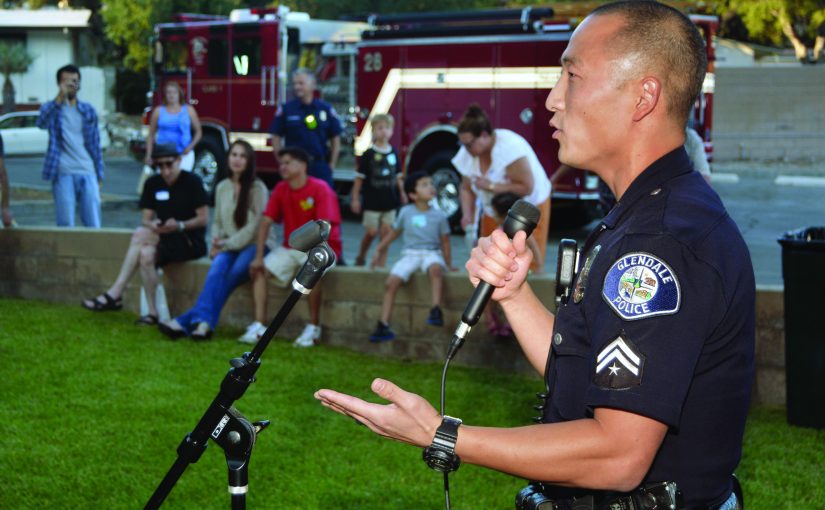When an agency thinks of violence reduction, the public information officer (PIO) might not be at the top of the list as a critical resource, but an individual in this role has the ability to create, share, and amplify messaging far beyond a single neighborhood or community group. While increased patrols and different response tactics are vital to addressing crime trends, keeping the public informed about what a department is doing, how, and why also goes a long way in enhancing these initiatives and catapulting the information to a larger audience.
The PIO can help an agency determine the best ways to share information about crime, from safety tips on specific topics to details about certain incidents to demonstrate transparency. Sometimes the situation calls for a sit-down media interview; other times it’s about getting information to certain hard-to-reach parts of the community via social media platforms. A PIO will know which option is best in a given situation and be able to guide the department. However, even if an agency does not have a dedicated PIO, these same tips and lessons learned can still be applied by other members of the department to meet violence reduction goals.
Recommendations for Agencies with PIOs
If an agency has a PIO, here are seven ways that person (or people) can help and why they are important:
-
- Create a communications strategy.
The PIO can come up with ideas for the overall best ways to address issues. The PIO sees the big picture of an agency’s overall mission, pinpoints the specific challenges, and then comes up with a variety of specific ways to address each of them individually. For example, if a department is seeing a spike in gun violence, a communications strategy could take the approach of sharing information with the community every time a firearm is recovered during an incident or sharing data about how often unsecured firearms are stolen from homes and vehicles or the areas with the most firearm thefts. Combine that information with safety tips about how to prevent those crimes from happening and an agency has a solid crime reduction strategy. These tactics show transparency and share crime prevention tips.
- Create a communications strategy.

But beyond that, creating a communications strategy gives the agency a codified plan for what topics are the most important and how they will be addressed, as well as how success will be measured. The latter part is important to ensure the right strategies are being deployed in the right ways. One example of that might be that, every Monday, a department will share on social media how many unsecured firearms were stolen over the weekend. The consistent social media post schedule keeps the community informed in a timely manner, regularly reminds community members to secure their firearms, and amplifies the work that patrol officers are doing every shift. It also teaches the community to expect such information in that format on that timeframe. The success can be measured in terms of reach (how many people saw or shared the post), engagement (how many comments were generated), or how many times the agency shared such types of posts.
-
- Navigate social media platforms.
Facebook, Instagram, Twitter, Nextdoor, Snapchat, TikTok, Reddit, and more—there are numerous social media platforms out there these days, and they are constantly changing algorithms and how best to reach different audiences. Don’t worry about using every platform that’s out there. What works in one community won’t necessarily work in another one. Larger agencies who have multiple PIOs can more easily navigate multiple social media platforms or those using third-party software to cross post more easily. Even then, each of these platforms is different and requires a lot of work to keep up with the comments and nuances of successfully posting to each one. For example, Instagram likes its hashtags to reach people, and if an agency is going to use TikTok, it better know how to be funny. Two agencies who are doing both well are the Seal Beach (California) Police Department on Instagram and the Anniston (Alabama) Police Department on TikTok. Their accounts have large followings because they’re smart about how they’re focusing on a specific social media platform and because they’re doing it well—they’re catching their communities’ attention and getting their crime prevention messages out. Seal Beach regularly shows their officers arresting individuals for violent crimes as a way to deter criminals from committing crimes in their city, and they’re communicating that message in a way that resonates with their community. Anniston shows the human side of their department as part of their recruitment efforts, which is a great way to draw applicants in, teach them about the department, and explain why the agency is a great place to work. Needless to say, increased staffing helps in all aspects of crime reduction. - Start small.
Like many things, there’s a tendency to throw everything and the kitchen sink at a problem. But when an agency uses every tool in the public information toolkit, it can be a bit too much. When that happens, the message can get lost in the delivery or reach a smaller portion of the community than an agency would like. Sometimes being hyper-focused on a particular area or goal is a great way to start to even determine if the strategy is the correct strategy. By starting small, an agency can get a better feel for whether the plan is working and how best to rework it to be more successful. Starting small also ensures the PIO isn’t overwhelmed when it comes to the workload. At many agencies, the PIO regularly gets “all other duties as assigned,” so when they’re starting new projects, starting small is more manageable among their other duties. - Consider traditional media.
Though the media landscape has definitely shifted in recent years due to the industry’s own staffing challenges and priorities, traditional media should be a community partner in that they can help a police department share critical information with residents. Media outlets have built-in audiences, sometimes going back longer than the police, and they may reach community members with whom the police struggle to connect. Is there a difference between a media outlet’s mission and the police agency’s mission? Absolutely. That doesn’t mean both can’t work together to give the other what it wants while benefitting each other and, ultimately, the community. One example might be a media interview to talk about a good arrest before the case has gone to trial. While the police department would need to be careful not to release too many details so as not to compromise the prosecution, it could give enough information to help the reporter tell a compelling story and simultaneously highlight the good policework being done to combat violent crime. - Arrange community meetings.
It may seem old school to some but having reliable in-person meetings to talk directly with the community can go a long way in helping to reduce crime. Face-to-face contact really resonates with community members, and the PIO officer can help arrange and moderate those engagements. They can also record, livestream, or even live tweet to further share the information beyond those in the room. Community meetings are a great way to reach a different part of a city because there are many residents who don’t watch the news or use social media but want to know what’s going on. The lift to host such a meeting can be a heavy one with the planning, communication, and managing day of, but the reward is worth it—direct engagement between community members and the police department.
- Assist with internal messaging.
One of the aspects of police communications that’s most overlooked is internal messaging. When it comes to operational plans, tactics are regularly communicated by rank from the top down but when the information is shared in different ways, it can help the department staff understand the plan and how each unit is working together to achieve the shared goal. The PIO can help draft this message or make suggestions to the leadership for the best ways to communicate new directives internally. One might ask why this is important if officers are already receiving direction via their chain of command, but seeing the overall big picture and how it all comes together gives them a different perspective. Then, officers can see how they’re all on the same team.
- Look at what other government agencies are doing (not just police).
Other government entities, as well as the private sector, are also vying for the public’s attention to share their messages. Everyone must get creative to be heard over all the other voices. Two great examples are the Oklahoma Department of Wildlife Conservation on TikTok, which masterfully weaves safety tips and important information into TikTok’s video tapestry of entertainment. Their account is funny and shares interesting information (including important safety tips and facts). In the police realm, the Fort Worth, Texas, Police Department also drew on humor when they created a recruitment video that went viral with its comparison to an old-school car salesman TV advertisement. Nearly every police department is struggling with recruitment and trying to find the best ways to attract new officers. Fort Worth’s video stood out because of their creativity and humor. Both agencies found unique ways to catch folks’ attention, and that’s one of the things that all police departments need to do when it comes to sharing information and safety tips to reduce violent crime.
Recommendations for Agencies Without PIOs
If an agency does not have a dedicated PIO, here are five things an agency can do:
-
- See above.
No, really. Any agency can modify the suggestions above based on their available resources, but the following are the ways an agency can do so more specifically. - Create a communications strategy.

Art Acevedo, City of Miami police chief, joins a Gun Violence Peace March on June 16, 2021, in Miami, Florida. Photo by Joe Raedle/Getty Images An agency does not need a dedicated PIO to develop its own communications strategy. The IACP has examples of communications strategies, and the PIO Section has several talented PIOs who’ve created such plans. Agencies can ask for examples and create their own based on those templates. Additionally, police agencies should consider partnering with other city or county communications teams or leadership who might have an overall city communications plan that can incorporate specific, violent crime reduction aspects. Policing is a team sport, and part of that is identifying who can do certain aspects of the plan. Who is skilled at talking to different audiences, regardless of the medium? Who understands social media? Those two people aren’t necessarily the same. Just because someone is a digital native does not necessarily mean they get the nuances of communication. But if everyone understands and works toward the mission, it can be accomplished.
- Participate in community meetings.
If an agency can’t plan, communicate, and host a big meeting or a series of regular meetings, what can it manage? For instance, police departments can find out when neighborhoods are holding their regular HOA or area meetings and ask for a few minutes on their agenda. Most communities already have such meetings scheduled, complete with communicating ahead of time so folks know what to expect. They’ve already done that part of the work for the department; it’s just on the agency to show up, share critical information, and be ready to answer questions. - Plan for internal messaging.
The agency may lack a PIO, but it likely has a talented administrative assistant who could draft an email that is reviewed by someone else before it’s sent out. Or a few different folks could take turns with this role, even using a software program that provides the template, leaving the person to fill in the blank when it’s time to send out an update. That makes it easier to share the workload as well. - Embrace the one-man band.
That phrase is often used by reporters or PIOs who are the sole person responsible for the job, but it can also apply to agencies without a PIO. Acknowledge and embrace the fact publicly that your agency is doing the best it can. A chief or sheriff can do that in a Q&A type of situation with the community. Go live on a social media platform with a loose agenda of information the agency wants the community to know about and then take questions live. It gives the community members a voice, which they love, and allows an agency to engage directly in a moderately controlled situation. It’s a win for everyone.
- See above.
Crime Reduction through Communication
For most people, perspective is reality. If people think they’re unsafe, regardless of whether they actually are, they will feel unsafe. That’s why it’s critical to incorporate public information tactics into a crime reduction strategy.
Overall, the mission is the same for agencies with or without a PIO: reduce violent crime. Agencies of all sizes and types can do that by focusing on the suggestions herein with the general guidance of being timely, being transparent, and being human. d
Please cite as
Dionne Waugh, “The Role of PIOs in Violence Reduction Strategies,” Police Chief Online, March 1, 2023.
- Navigate social media platforms.



